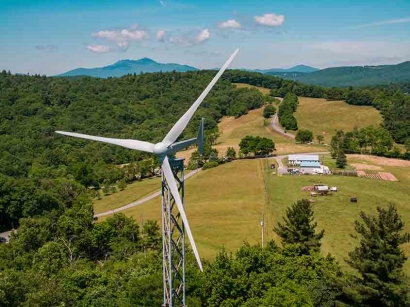Applications will be accepted through April 1, 2022.
Managed by NREL on behalf of DOE’s Wind Energy Technologies Office, the CIP awards cost-shared subcontracts and technical support to make distributed wind energy more cost competitive, improve its interoperability with other distributed energy resources, and increase the number of small and mid-scale wind turbine designs that have been tested to national standards. The 2022 RFP includes a new topic area that takes the program’s impact one step further by supporting the costs associated with the commercialization process and development of partnerships with a pathway to larger-scale deployments.
“Over the last decade, CIP has supported small businesses in multiple phases of the product-development cycle, resulting in significant cost reductions in distributed wind energy turbine technology while simultaneously improving product reliability and market readiness,” said Ian Baring-Gould, NREL distributed wind energy program lead. “As we look to greatly expand the use of clean energy, CIP is also evolving to support commercialization by addressing barriers to rapid deployment of these improved distributed wind energy technologies.”
Exemplifying the impact of CIP on the U.S. distributed wind energy industry :
- Bergey Windpower (in Norman, Oklahoma) developed and achieved certification through third-party verified testing for safety, function, performance, and durability for the Bergey Excel 15 wind turbine, which has reduced the cost of energy by 50% compared to the Bergey Excel 10 wind turbine.
- Pecos Wind Power (in Somerville, Massachusetts) prototyped a new 85-kilowatt (kW) wind turbine engineered specifically for the U.S. distributed generation market, resulting in an expected cost of energy 55% lower than comparable installations
- Primus Windpower (in Lakewood, Colorado) achieved turbine certification on two of the company’s turbine models.
- Intergrid LLC (in Temple, New Hampshire) developed a modular power inverter for wind turbines under 25 kW to meet updated grid integration requirements and fill a distributed wind energy industry gap by delivering an interconnection-code-compliant inverter designed for compatibility with other distributed energy technologies.
- Carter Wind Turbines (in Wichita Falls, Texas) modernized their 300-kW turbine with a new rotor design for increased energy production in lower wind speeds and developed controls and power electronics to integrate battery storage and provide enhanced resiliency through emergency backup power.
- QED Wind Power (in Tucson, Arizona) initiated field testing, certification, and electrical safety listing of their 20-kW turbine, which can integrate into existing grid infrastructure or operate off grid in isolated communities.
- Eocycle America (in Stowe, Vermont) advanced their 100-kW M series turbine with a new optimized rotor design for maximum yield at sites with low to medium wind speeds and integrated storage to provide resiliency and grid stability enhancement.The Bergey Excel 15 wind turbine, developed through CIP, has reduced the cost of energy by 50% compared to the Bergey Excel 10 wind turbine.
The 2022 RFP focuses on projects that:
- Develop new, innovative distributed wind energy concepts
- Transform and optimize existing designs for lower cost, increased energy production, or expanded capabilities, such as advanced grid support to enhance power system resiliency
- Conduct wind turbine and component testing to national standards to verify performance and safety
- Develop advanced manufacturing processes to reduce hardware costs
- Accelerate pathways to commercialization.
The RFP includes cost-share requirements, and proposals must provide evidence of technical readiness, incorporation in the United States, strong team skills and capabilities, and financial information. Work funded under this effort is expected to take place in the United States and/or U.S. territories unless otherwise justified.
To view the CIP RFP and find additional background information, visit the CIP project website.


